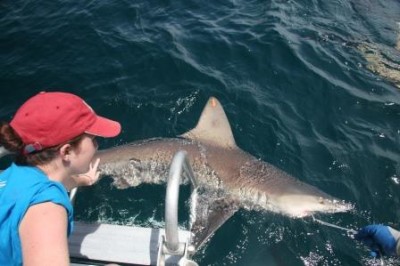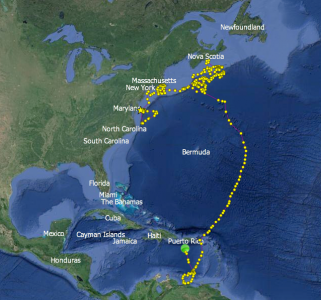NSU Newsroom
SharkBytes
Horizons
This version of NSU News has been archived as of February 28, 2019. To search through archived articles, visit nova.edu/search. To access the new version of NSU News, visit news.nova.edu.
This version of SharkBytes has been archived as of February 28, 2019. To search through archived articles, visit nova.edu/search. To access the new version of SharkBytes, visit sharkbytes.nova.edu.
Shark Tagged by NSU’s Guy Harvey Research Institute Apparently Enjoying Time in Warm, Tropical Waters

Numerous species of sharks are tagged including this Sandbar shark (Carcharhinus plumbeus), which was caught for tagging and genetic sampling in Hollywood Beach, FL.
Like his human counterparts, it seems a shortfin mako shark tagged by researchers at Nova Southeastern University’s Guy Harvey Research Institute (GHRI) has decided to visit the tropical waters off Puerto Rico.
The shark, dubbed “St. Mary’s” as it’s named for a school in Ohio, has “pinged” off the coast of Puerto Rico. The shark was originally tagged off Ocean City, Maryland last May.
The five-and-a-half-foot juvenile male shark is among more than 40 mako sharks satellite tagged and being tracked by researchers at NSU’s GHRI. The institute began tagging mako sharks in 2009 to study their migratory patterns and now undertakes expeditions worldwide to study them. The school’s marine experts have tagged mako sharks as far away as Mexico and New Zealand. In addition to makos, GHRI scientists are also tracking tiger, oceanic white tip and sand tiger sharks, as well as blue and white marlin.
This particular shark has shown quite the dramatic swim track – spending time in northern waters and then suddenly, and dramatically, turning and heading almost due south. St. Mary’s, which was caught, tagged and released on May 17, 2014, has traveled more than 7,300 miles, visiting the waters off Nova Scotia, south through the open Atlantic to Venezuela and north towards Puerto Rico.
Mahmood Shivji, Ph.D., professor at NSU Oceanographic Center and director of NSU’s GHRI and Save our Seas Research Center said his researchers have special interest in understanding mako shark migratory behavior because this information is essential for proper fisheries management and conservation of this internationally roving species.
You can follow St. Marys and other shark movements in near real-time online at (www.ghritracking.org).
